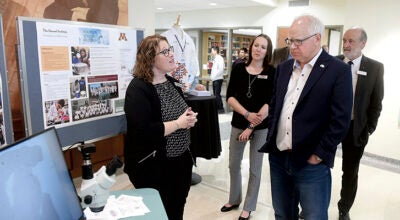Cities, counties could lose big
Published 6:44 am Friday, February 19, 2010
This week, Gov. Tim Pawlenty released his proposal to balance the state’s immediate $1.2 billion budget shortfall. Lawmakers now are reviewing the plan and beginning to craft our own proposal that will be negotiated with the governor’s between now and the end of session in May.
Looking at the governor’s budget, there are some good ideas. He offers some plans for government reforms and spending cuts that I think we all agree are needed. Lawmakers will definitely be focused on similar goals when looking at how to solve the budget deficit.
Where we make those spending cuts will likely be very different, however. Much of the governor’s plan relies on cuts to nursing homes, police and fire protection, and other core government services. I am not alone in worrying that these cuts will have dramatic, long-term consequences for our communities and the entire state if enacted.
This week, Austin City Administrator Jim Hurm and three council members — Janet Anderson, Jeff Austin and Marian Clennon — joined me in St. Paul for Coalition of Greater Minnesota Cities Day at the Capitol. It was very helpful for me to be able to talk to them first-hand about what the governor’s proposed cuts could mean for our area. They told me they share many of the same worries about what the governor’s budget could mean for Austin, in particular.
Part of the governor’s budget proposal relies on $250 million cut to local government aids this year, and a half-billion dollars in cuts in 2011. Cities and counties use the majority of this money to fund road maintenance and public-safety services, such as police and fire protection. In order to offset state aid cuts, local governments must choose between cutting these core services and local jobs, or raising property taxes on local homeowners and business owners.
When the governor used unallotment to balance the budget last June, he cut $876,833 in Local Government Aid to Austin. Under his current budget proposal, he would cut an additional $970,786 in Austin LGA this year.
That would mean a total $1.8 million cut to the city’s budget in 2010 alone.
Smaller cities surrounding Austin also would be impacted. Last year’s unallotments included an exemption for small cities, but this year’s round of cuts does not. Adams, for example, is at risk of losing $34,305 in LGA — a big hit for a small community. Counties are not spared, either. Mower County is recommended to endure $770,653 in additional cuts; Fillmore County would see $389,715 cut; and Freeborn County, $853,274 cut.
The link between state funding cuts and property taxes isn’t just speculation. A State Auditor’s report issued last month shows that as state funding to cities has decreased in the past 10 years, city property tax revenue has increased by 102 percent. The study also showed that city spending has actually declined during the same time period — clearly, cities and counties are working hard to make do with less.
Mower County, for instance, already has endured $440,000 in County Aid cuts this year and has made a series of budget reductions to deal with that shortage. Officials have said if the governor’s newest round of budget cuts goes through, the county will be forced to either look at property tax increases or lay off 40 employees. Those are real jobs in our community that would be eliminated. And those are real taxes that every homeowner and business owner would be expected to pay.
Without those cutbacks, however, this type of budget cut would devastate the county’s ability to keep up the most basic services we all rely upon, such as snow-plowing and road maintenance. Local governments are very literally being backed into a corner with these irresponsible state decisions.
Balancing the state’s budget by making cuts that simply are passed onto others — whether it’s local governments, property tax payers, school districts or businesses — is not effective leadership. These types of cuts create deeper, ongoing problems that will just need to be addressed in the future. It’s my hope that the legislature can come together and implement a more long-term, realistic budget plan that doesn’t end up costing everyone more money in the future.
As always, please don’t hesitate to share your comments with me. You may reach me at sen.dan.sparks@senate.mn; 651-296-9248; or Room 317
State Capitol, St. Paul, MN 55155.
– Senator Dan Sparks





